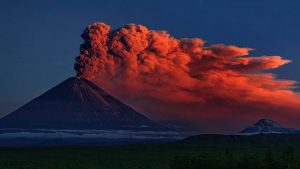
Geochemical fingerprinting links microscopic ash found on the bottom of a Svalbard lake to volcanic event happening 7000 years ago and 5000 km away.
Eruptions are cataclysmic events that may impact people living far from their volcanic sources. Just think back to the summer of 2010, when ash from an obscure Icelandic volcano blanketed European airspace, disrupting flights for weeks.
A new study now demonstrates that volcanic ash can travel even further, linking microscopic ash from an Arctic Lake to a 7000 year old eruption on Russia`s Kamchatka peninsula.
Beyond the usual suspects
This find, recently published in the scientific journal Quaternary Science Reviews, expands the known dispersal range of volcanic ash by thousands of kilometers.
“Being both volcanically active and lying nearby, I expected our ash to originate from Iceland: this study really highlights the need to look beyond the usual suspects in this line of research,” Willem van der Bilt, lead-author and researcher at the University of Bergen and the Bjerknes Centre for Climate Research points out. The results also raises questions about the factors influencing the dispersal of volcanic ash.
“The eruption that produced our ash was larger than most, but smaller than others who did not spread out their ash across the Hemisphere. Day-to-day shifts in weather factors like the speed and direction of winds surely helped this ash come such a long way,” van der Bilt says.
Electron beam bombardment
To find the ash, van der Bilt and his co-authors carried out a range of delicate lab procedures in various specialized labs across Europe.
“In the end, we found and analyzed 6 particles with less than half the width of a human hair: quite literally, more than meets the eye,” van der Bilt adds.
First, ash was separated from lake sediments — like skimming off foam from milk. Next, ash was identified under a microscope and extracted during a tricky maneuver with a 10 cm long needle. Finally, in a procedure that seems to come straight from a science-fiction movie, individual ash particles were bombarded by an electron beam to determine their chemistry.
“Like human DNA, the composition of volcanic ash is unique. Geochemical analysis help us fingerprint this signature and match it with an eruption,” says van der Bilt.
Time flies
But the implications of the paper go beyond challenging assumptions about the distance that volcanic ash clouds can travel. Most volcanic ash settles on the ground within weeks after an eruption, forming layers of identical age in geological records like the analyzed lake sediments.
“Thinking about the dispersal and deposition of such ash markers in this way, time quite literally flies. The ash we found travelled across three continents and allows synchronization of all the records taken from its vast fallout areas that contain it. If such records hold information on past climate change, our ash marker enables us to investigate cause-effect and lead-lag relationships in Earth`s climate system — information that is highly valuable to help understand processes driving climate changes like those seen today,” van der Bilt concludes.
Reference:
Willem G.M. van der Bilt, Christine S. Lane, Jostein Bakke. Ultra-distal Kamchatkan ash on Arctic Svalbard: Towards hemispheric cryptotephra correlation. Quaternary Science Reviews, 2017; 164: 230 DOI: 10.1016/j.quascirev.2017.04.007
Note: The above post is reprinted from materials provided by University of Bergen.









